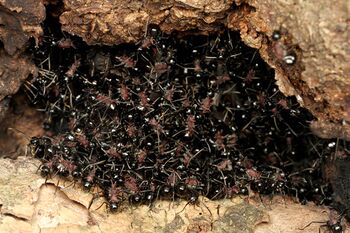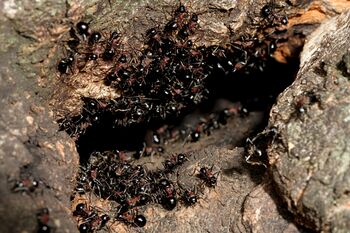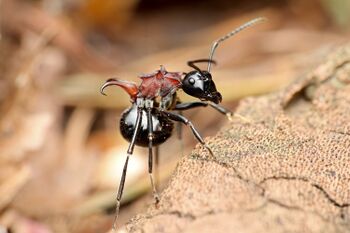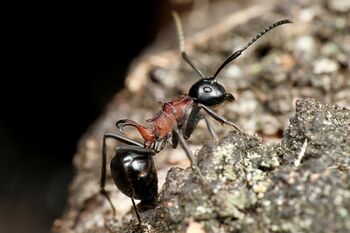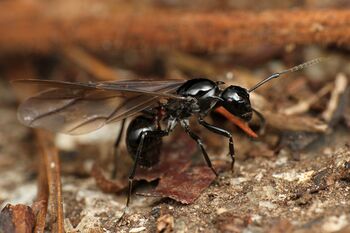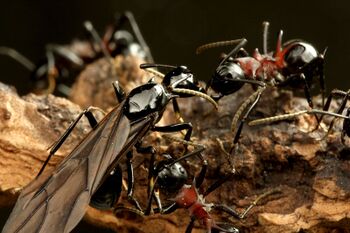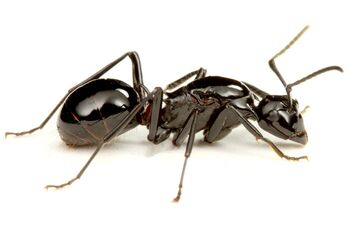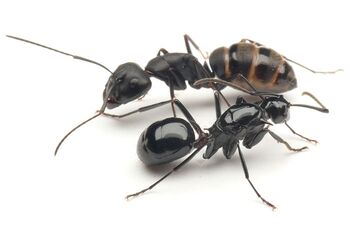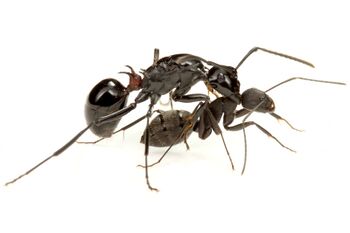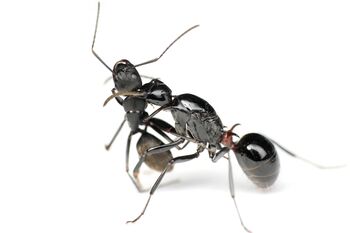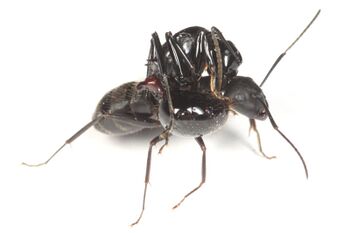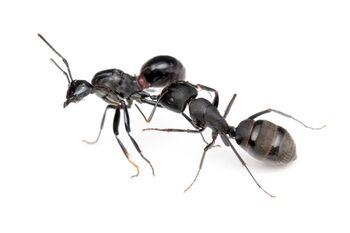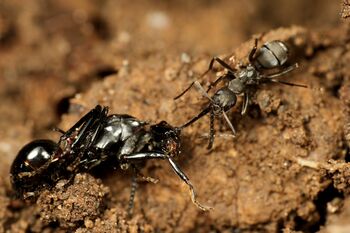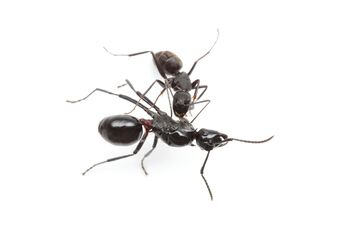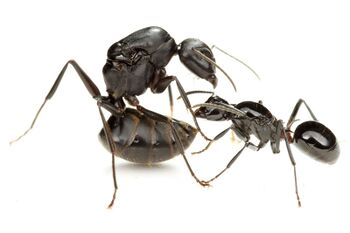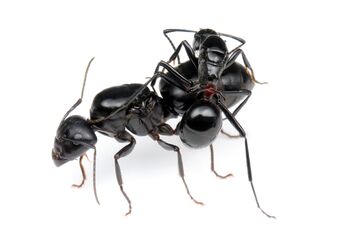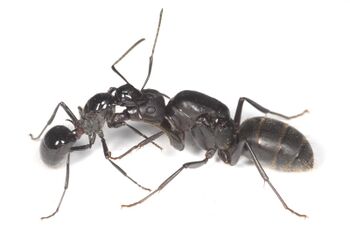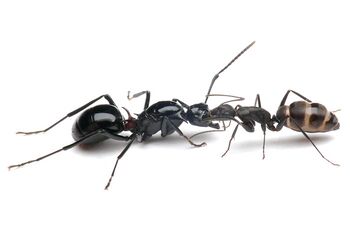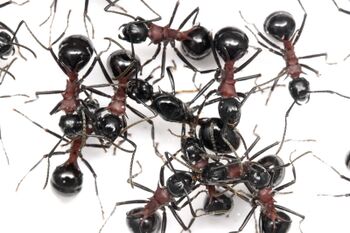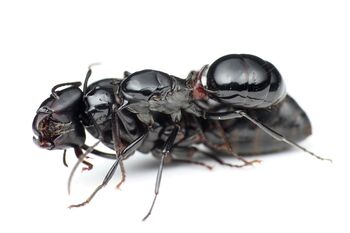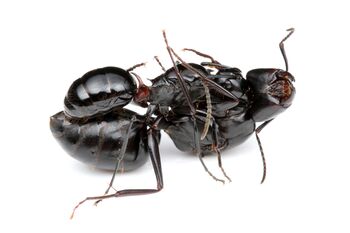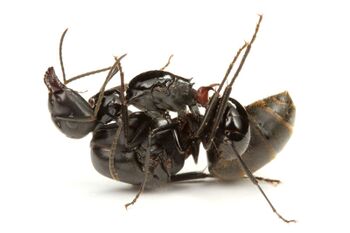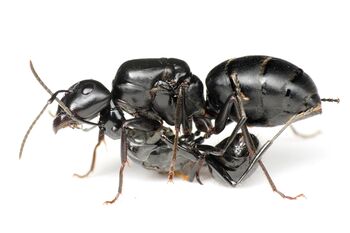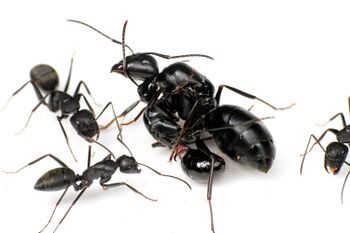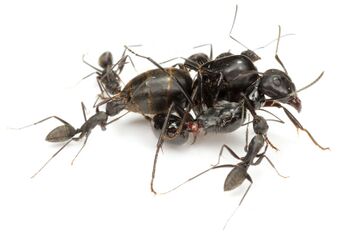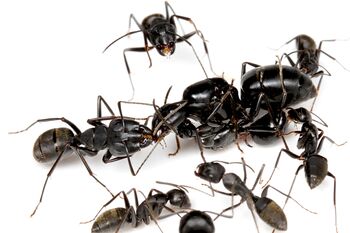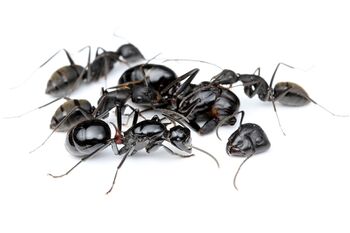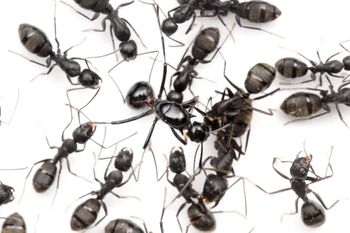Colony Founding in Polyrhachis lamellidens
The following observations were made by Taku Shimada and reported on his blog site AntRoom between 2010 and 2015 (in Japanese, translated and summarised here). Observations were made both in the field as well as in laboratory colonies and involved numerous colonies collected over a number of years.
Polyrhachis lamellidens is commonly found in thick forests where it nests in cavities in living trees. This placement offers considerably more protection when compared to nests in soil or decayed trees; anyone who has attempted to collect these ants will be familiar with this. During warmer weather foraging workers and those tending the nest will aggregate around the nest entrance, making nests obvious even to casual observers. In some cases these aggregations can become so dense that workers seem to become entangled with each other, forming a mass of workers.
Summary of Colony Founding
The following steps seem essential for the successful establishment of a new colony by P. lamellidens queens (details below):
1) A mated Polyrhachis lamellidens queen locates a nest of Camponotus japonicus.
2) A foraging C. japonicus worker is captured and subdued. The queen’s fore legs are used to transfer scent from the worker to her body.
3) The host nest is invaded and the C. japonicus queen is located.
4) The P. lamellidens queen attaches herself to the host queen's neck. They stay in close contact and transfer scent for up to 2 weeks. Host workers do not distinguish between the two queens and feed both.
5) The host queen is killed.
6) Workers feed the P. lamellidens queen over the winter, with her ovaries developing during this period.
7) In spring, egg-laying begins with host workers tending the brood.
8) Over time, host workers die and are replaced with P. lamellidens workers. Eventually the colony becomes pure Polyrhachis lamellidens.
Details of Colony Founding
Mating flights occur from September to November, which is one of the latest flight times known for Japanese ants. After the mating flight, queens disperse across the surface of the ground and are highly susceptible to attack by a range of predators, including the non-native weed turtle, Agriosphodrus dohrni, and Formica japonica workers.
Locating a Host Nest
Newly mated queens do not establish nests independently, but do so by invading an established nest of Camponotus japonicus. However, very few queens succeed in locating and successfully invade a C. japonicus nest in nature and it is rare to find mixed P. lamellidens/C. japonicus nests. It is, however, common to find many dead P. lamellidens queens near entrances of C. japonicus nests during the mating season. These dead queens appear to have attempted to invade a C. japonicus nest but were either killed by the potential host workers or by the host queen within the nest. While detailed studies have not been undertaken, it is likely that less than 1% of the new queens succeed in establishing themselves within a nest of their host.
Capture of Host Workers
Before attempting to invade a C. japonicus nest, a P. lamellidens queen captures foraging C. japonicus workers and transfers their scent to her body. To do this, the queen holds C. japonicus workers from above, biting the neck or petiole with her mandibles, but she does not kill them even though they initially struggle. Eventually the C. japonicus worker becomes quiet and the P. lamellidens queen begins stroking the worker’s body with her fore legs. She then grooms her own body with her legs, transferring the worker’s scent to her body. Fine brush-like hairs on the queen’s fore legs combined with her smooth body likely increases the transfer of these scent compounds. This process normally involves the queen and single or very few C. japonicus workers, with the queen’s pronotal spines protecting her neck and her petiolar spines protecting the vulnerable petiolar region from attack by the Camponotus workers. However, if large numbers of C. japonicus workers are present the queen is often attacked and overwhelmed, resulting in her death.
Invading the Host Nest
Once the transfer of host scent to the queen is complete, the queen can invade the host nest without detection by host workers. However, if the scent is not sufficient, the queen may be attacked by C. japonicus workers when entering the nest, and be killed. If she remains undetected, her next task is to locate the C. japonicus queen. The invading queen moves deep into the nest in search of the queen and when the queen is located, she clearly recognises it as her movements and behaviors change. But even here, the P. lamellidens queen is sometimes attacked and seriously injured, or occasionally killed, by the much larger C. japonicus queen. If she is not detected and attacked, she stays near the C. japonicus queen.
Attacking the Host Queen
Eventually the P. lamellidens queen locates the host queen’s head and bites her neck. At this stage she is unlikely to be attacked by the workers around her as they are unable to distinguish the two queens. In fact, host workers will feed both queens, a clear indication they can not distinguish them. The two queens stay together for 7 to 14 days after initial contact. During this period additional scent is transferred from the C. japonicus queen to the P. lamellidens queen and she feeds on fluid from the host’s wounded neck.
Killing the Host Queen and Replacing Host Workers
Eventually, the C. japonicus queen is killed and the nest is hijacked. The Polyrhachis queen is accepted by the colony and is fed and groomed by C. japonicus workers as if she were their own queen. The queen consumes considerably more food than previously, resulting in a visibly swollen gaster, the result of her developing ovaries. Full-fledged egg laying begins in the spring after overwintering and the eggs and larvae are tended by C. japonicus workers. As P. lamellidens workers emerge, both host and parasite workers coexist within the nest. As time passes, host workers die and the colony becomes pure P. lamellidens.
Advantage of Temporary Parasitism
By usurping an established nest containing a large number of workers, the queen can lay many more eggs than an independently nest-founding queen and avoid the dangerous initial stages of nest establishment. From experience with captive colonies, it is known that the number of eggs laid by a queen depends mainly on the number of workers present rather than the age of the queen. A queen who has just finished a nuptial flight usually lays between 10 and 20 eggs, but even young queens can lay hundreds of eggs if they live artificially with a large number of workers.
| ||||||||||||||||||||||||||
